Killer bubbles
The terrible power of imploding water
If the loudest animal on Earth is the sperm whale, a giant squid killing deep sea monster, what is the second loudest?
A sperm whale can make a sound of about 230 decibels, which is louder than a jet engine. It needs to do this because it hunts giant squid in the blind depths of the deep ocean, and uses powerful sonar pulses to both locate, and stun, the Kraken while hunting.
But consider for a moment: What do you think the second loudest creature on the planet is?
You would be forgiven for thinking it was another whale, given that they are gigantic beasts that must traverse the inky waters, bellow songs over many miles and hunt with bursts of cacophonous sound… but you’d be wrong.
The second loudest creature in the world is a shrimp less than two inches in length. It’s called the pistol shrimp, and it’s an assassin.
The pistol shrimp can produce an acoustic pressure pulse of 189 dB (some studies have estimated over 200), which is louder than a large calibre rifle. It’s so loud, in fact, than in World War 2 the US Navy was reported to have used pistol shrimp colonies to hide submarines, as their background gunshots interfered with sonar detection. How does a tiny shrimp do such a thing?
It uses cavitation: The terrible power of imploding water.
1: Steam by other means.
Water has a boiling point, at normal sea level pressure, of 100 celsius, which is a temperature seldom reached in nature, and good thing too. What is not always appreciated to non-engineers is that water’s boiling point changes with pressure. As you may have noted if you’ve been following these articles, that can be useful: Raise the static pressure of water and you raise its boiling point, which is useful in power generation such as nuclear pressurized water reactors, where heating the water to over 300C would vaporise the liquid, were it not pressurised to an almighty 150 atmospheres. Likewise, it can be useful as well to inspire boiling: A multi-stage flash distillation unit (also covered in a recent article of mine) deliberately lowers the pressure in successive tanks of heated brine, to encourage the water to flash into clean steam.
But while the manipulation of boiling points through pressure is a useful trick, it can also be a dangerous one, that can wreck propellors, break valves, strip paint and, of course, let the pistol shrimp shoot things.
It’s called the Bernoulli principle: In an idealised inviscid fluid, kinetic energy, static pressure and potential energy are conserved, meaning that if you massively increase dynamic pressure (the energy required to bring a unit of fluid to a dead halt) while keeping potential energy the same, this is balanced by a reduction in static pressure.
In short: If you use a venturi or the upper surface of a hydrofoil to locally accelerate water, you also locally reduce the static pressure of it. And if you do this too much…
Cavitation.
Spin a propellor too fast, or concentrate flow through a valve or a venturi too much, and local acceleration drops the pressure far enough for spontaneous vaporization to occur at ambient temperature.
Great. Lovely. So what has this got to do with propellors and pistol shrimp?
The pistol shrimp, tiny assassin, is easily identified by a single oversized claw. This claw can retract and ‘pinch’ at tremendous speed, squeezing water out of a special cavity, which accelerates through a narrow orifice at about 100 kph in an instant. The local pressure drop induced by this then causes cavitation, and the formation of a steam bubble. But this bubble doesn’t last long.
As soon as it has passed the low pressure zone, physics returns with a vengeance and the bubble implodes. With spectacular force.
The acoustic shockwave generated by the collapsing bubble will kill a pistol shrimp’s prey and deafen sonar systems, and it gets much worse than that…
The collapsing bubble causes a massive pressure spike within the steam bubble, just for an instant, that raises the temperature at its core to thousands of degrees. This spectacular pulse of heat and pressure, for the tiniest fraction of a second, causes trace gases to ionize, and in a process called sonoluminescence, produces a faint flash of light in the pico to nano-second range.
This tiny two inch shrimp can box its prey so hard that it actually creates light.
2: Pulverising Propellors.
You might expect such a violent process to be a design constraint on things underwater. You’d be right.
Cavitation forces speedboats to require specially designed props, as the very high speeds on normal props will generate cavitation effects that can rapidly eat the prop away. Likewise, valves in pipework subject to high pressure gradients can erode and degrade rapidly when exposed to cavitation. I have a tap in my kitchen that, if set to just the right setting, will produce a loud groan and deliver to me a churning, cloudy stream of water. In that, too, cavitation is exacting its toll on the metal of a valve I can’t see.
Indeed, cavitation even effects animals: Warm-blooded fast swimmers, like dolphins, are likely to be constrained by cavitation when swimming near the surface (because cavitation is a static pressure effect, increasing depth suppresses it). Cavitation is thought to occur over flippers and caudal fins at speeds of 10-15 metres per second, or 20-30 miles per hour. Large surface predators in the Scombridae family, which includes tuna and mackerel, have been seen with cavitation damage on their caudal fins. Since fish don’t have nerve receptors on these fins, it’s possible for them to pass the cavitation threshold temporarily. Fast swimming mammals like dolphins, on the other hand, will feel pain when the cavitation threshold is reached, so this could be a real speed limit for them.
How on earth does cavitation cause so much damage?
The collapse of an individual cavitation bubble is a pretty low-energy event, but the problem lies in the duration: The collapse happens fast! It also happens asymmetrically, collapsing preferentially on one side and generating a high speed microjet as well as an acoustic shockwave. This low-energy, high-power event can cause localised surface damage if the energy from the collapse is directed into the surface, initially producing tiny pits, about a tenth of a millimetre across. Over time, if cavitation collapse occurs in the same place, which it typically will, this will have a cumulative effect: Paint or surface layers can delaminate, allowing acoustic pulses and local water to attack what is beneath and causing rapid runaway erosion.
This can also be dangerous in faster, more obviously destructive ways: If cavitation collapse starts occurring on a military submarine propellor, for example, it basically broadcasts its position to everything with a sonar detector, which could spell imminent death to the sub through more pyrotechnic means.
3: Tiny Depth-Charge
Think of a cavitation collapse as being like a tiny depth-charge: As we know from watching any number of World War 2 movies, a depth charge is an explosive that is sunk after being primed to go off at a certain depth. It’s used to destroy submarines.
What is not always appreciated is that it’s not necessarily the initial explosion that does the damage, as water naturally cushions the expansion of the vast bubble generated by the charge: The collapse, though, is rapid, accelerative and produces directional jets that can seriously damage nearby structures.
And so it is with the cavitation bubble: If the bubble collapses near a surface, then the interference effects on local pressure caused by this surface during the collapse will distort it: All things being equal, the bubble will preferentially collapse faster from the freestream direction, casing an asymmetric collapse which exaggerates over time until the collapsing sphere becomes a sort of imploding donut, generating a microjet. It is this microjet, in addition to the subsequent acoustic shockwaves when the remainder of the bubbles implodes, that causes the fatal one-two punch of the cavitation collapse.
But wait! There’s more!
Cavitation is rarely a one-bubble event. In reality, a cloud of tiny bubbles will cavitate right next to each other, and will implode together. This creates all kinds of interesting interactions: See the images shown, where interacting bubble pairs can produce discs, or pierce each other into a spike-&-torus, which then implodes directionally into a spearlike microjet.
Cavitation is nature’s bullet: Small energy but delivered to a tiny area in a tiny time.
Would you catch a bullet?
4: Killer bubbles.
Avoidance is key.
Take this image for example of a propellor in a hydro-tunnel. You can see three visible cavitation structures:
Firstly, over the quarter-chord of the prop’s suction surface, where pressure over the surface is lowest, there’s a visible cloud of cavitation bubbles. This is a nuisance not just because it distorts the flow around the prop, impacting efficiency, but also because there’s a clear line of bubble implosion where the cloud is cut-off after the quarter chord (where the static pressure increases again). This is where surface damage will occur.
Most dramatically, the tips of the prop shed attractive spiral bubble-clouds. This is due to the trailing vortex, that curls up over the tip of the prop as the high pressure region reaches over into the low pressure suction side, and the little interactions merge into a big trailing vortex. The centre of a free vortex can rotate at impressive speeds, so static pressure here is low and cavitation is carried downstream. The bubbles eventually implode well away from the prop, so are not structurally dangerous.
Just visible in the centre, trailing behind the prop, is a central line of bubbles, where a free vortex detaches from the rear of the prop. This is fed energy from the forced water column rotation caused by the rotating prop, but concentrates into a free vortex at the centre. Again, not likely structurally dangerous unless the flow is curling back over the blunt rear of the prop and causing a stagnation effect there.
If we know where to look, and how to test for it, we can design our way past cavitation, but that isn’t as easy as it sounds.
When testing ship hydrodynamics for example, you might want to use a scaled model in a tow tank, much like you'd use a wind tunnel with a miniature scaled aeroplane model, but scaling becomes a big challenge when one of the factors you want to simulate is cavitation.
When placing an aircraft model in a wind tunnel, one of the factors you'll need to keep equivalent as you miniaturize it is Reynolds number: This is the balance between kinetic forces and viscous influences in a moving fluid, and determines the likelihood, and location, of flow transition from laminar to turbulent, and many, many kinds of flow behaviour. Typically this means that if you shrink your model, you need to increase your flow velocity to compensate, or else use a different fluid with higher density but lower kinematic viscosity.
For ships this doesn't work very well: Because seagoing vessels tend to be much bigger than aircraft or aerofoils, you need to aggressively scale to fit them in the tow tank (down to a 1:30 scale model). To match the Reynolds number would mean increasing either flow velocity by 30, increasing fluid density by 30 or reducing fluid viscosity by 30. All of which is ridiculous, and would also wreck your cavitation study.
Fortunately you don't have to.
Water has a high density and a low kinematic viscosity. Plus ships are massive, so Reynolds numbers are typically so high, and so far above the turbulence transition threshold, that you don't have to scale too aggressively for it in a hydro tunnel or tow tank. Plus, there are more important flow parameters…
A ship is sensitive to buoyancy effects and wake & wave patterns, which are in turn influenced by gravitational acceleration, which you can't change here on Earth. That means that to keep your ship model dynamically equivalent in a small-scale tow tank you can't increase flow velocity. This can be a nuisance, as it influences your cavitation index.
The cavitation index is the parameter you want to keep the same between model and reality if you're studying cavitation: p0 is the reference pressure, pv is the water vapour pressure, then there's density and velocity squared. As a result, if you lower the velocity by half, You need to lower that pressure gap to a quarter of its previous level. Drop the velocity to 10% and the pressure gap becomes 1%, etc.
Bummer.
The solution: Depressurize your tow tank!
MARIN (Maritime Research Institute Netherlands), for example, has a 260 metre long tow tank for self-propelled ship models and still needs the ability to get it down to 2.5% of atmospheric pressure to be sure of getting cavitation conditions right.
Wow.
5: Useful bubbles.
As with most forms of destruction, cavitation can be used creatively as well. The dynamics of cavitation implosions are bizarrely intense, fast events which border on the alien, but technology is a big tent with lots of room for the alien.
Ultrasonic cleaning can be used for a variety of purposes: Restoring patterned china, cleaning cloth, cleaning high purity surfaces such as precision moulding tools. It works by immersing the item to be cleaned in a heated bath, where it is plied with pressure waves in the ultrasonic range. The pressure modulation that ensues causes local vaporization and formation of cavitation bubble clouds which, in their inimical way, implode with great viciousness. This can clean surfaces.
Cavitation also helps with laser lithotripsy, a technique using a probe-mounted laser that is manoeuvred into a patient's urethra to break up kidney stones. Try not to wince at that! As well as the laser’s photothermal ablation, kidney stone breakage is aided by the formation of cavitation bubbles, whose collapse and acoustic shock generation, on a micro scale inside your body, can break up kidney stones from the inside.
I know: It sounds useful, but you wouldn’t want it done to you!
But if bubble implosions have the capacity to create, why not take it further: They might, just, have the ability to create energy itself. Boundless, endless energy.
Is it just a dream? Almost…
6: Hot bubbles!
The strangest story about cavitation is one mired in the viscous embrace of scientific fraud, and a beautiful dream.
Sonofusion!
In 2002, Dr. Rusi Taleyarkhan of the Oak Ridge National Laboratory, Tennessee, reported an unbelievable finding: He claimed he had succeeded in generating tabletop nuclear fusion using a cavitation device on Deuterated acetone, allegedly triggering the nuclear fusion of deuterium, an isotope of hydrogen, and detecting the neutrons produced by this event.
Move over ITER: Turns out you don't need 20 billion quid to burn a fusion plasma. You just need a desktop acoustic array, and Dr. Taleyarkhan.
The theory is that cavitation implosion events are so rapid and so intense that they might, just, reach the conditions required to trigger nuclear fusion. Nuclear fusion is where light nuclear particles, like hydrogen isotopes, are smashed together with sufficient ferocity to overcome the electromagnetic force that repels positively charged nuclei. On combining two light nuclei into a larger, more stable one, the binding energy per nucleon goes way up, and there’s a huge energy release. This is the fundamental principle behind nuclear fusion, in simple form.
The sun achieves nuclear fusion very, very slowly by dint of being very hot and absolutely bloody enormous, and even then the power density of our sun is very low; about the same as a large compost heap. It adds up just because the sun is immense. For us to repeat that trick on the small scale, without a billion billion billion tons of hydrogen to hand, means cranking up the temperature and the pressure: Fusion reactors need temperatures of hundreds of millions of degrees, so how on earth do we generate something so intense with a bubble?
The idea isn’t completely without merit. Taleyarkhan used 15 bar acoustic pressure waves to trigger cavitation, which is much more intense than the cavitation events we’ve discussed so far. Additionally, noble gas line emissions have shown hints that truly crazy temperatures are achievable inside cavitation bubble implosions: 16,000 kelvin plasmas have been observed inside them for vanishingly short instants.
But while 16,000 degrees is impressive, it’s a few orders of magnitude short of what’s needed for nuclear fusion…
Well that’s where mystery can form a myth: Plasma generation actually prevents researchers from seeing right to the core of an imploding bubble, so who knows what happens, just for a few picoseconds, inside that collapsing plasma core, hemmed-in by implacable liquid?
It could be the stuff of myth & legend… or fraud.
Numerical analysis shows that with certain assumptions, the light element temperatures in an imploding bubble core could reach up to 10^8 kelvin: A hundred million: Fusion territory!
Or maybe not. It’s supposition.
To enable fusion ignition, the igniting of fusion fuel with sufficient intensity to ignite yet more fuel and sustain an ongoing reaction, the Lawson Triple Product (ion density x temperature in KeV x time) must be staggeringly high: For deuterium-tritium, probably the easiest fusion combination, this magic number is 5x10^21, which is humongous. Even under the ambitious numerical simulation models above, bubble-collapse falls short as a mechanism to sustain fusion, as its picosecond-long surge is just too quick.
And true to form, other researchers found that they couldn’t replicate Dr. Taleyarkhan’s results. Other researchers cast further doubt, noting that the neutron energies seen in his results matched that of Californium decay, a known neutron emission source that is very definitely not undergoing nuclear fusion. Over time, Dr. Taleyarkhan’s behaviour became withdrawn and erratic, and it became obvious that he had fallen for the tempting pitfall of the Scientist With An Ego: He had committed scientific fraud.
And that was that, for sonofusion. The field was poisoned by association, it’s ground well & truly salted and new talent turned away from it in scorn.
Which is a pity. Deuterated acetone came to nothing, but it’s not completely beyond the bounds of possibility that something else would work. Maybe bubble clustering could up the pressures or durations sufficiently. Maybe combining ultrasonics with a venturi-focused waterjet could do it. Maybe eschewing deuterated acetone and going straight for liquid metals would allow the implosion dynamics to work sufficiently.
Nobody knows, and nobody’s looking. You wouldn’t risk your career on it, would you?
7: Weird bubbles.
Cavitation is one of those strange things in engineering: Completely unknown to the public, even most engineers don't have to deal with it, but for those who do this mysterious force is all-important.
A crackle in the depths. It can do great things, or it can wear you out and kill you.
It's steam, but not as we know it; a freaky aberration in physics that disappears in an instant, leaving only noise, heat, and a faint glow. You can live your life in comfortable ignorance of it until it becomes important, but one day you'll hear the groaning of a valve and wonder.
Or the crackle around a propellor.
Or, over distant underwater mounds, the snapping laughter of the pistol shrimp.


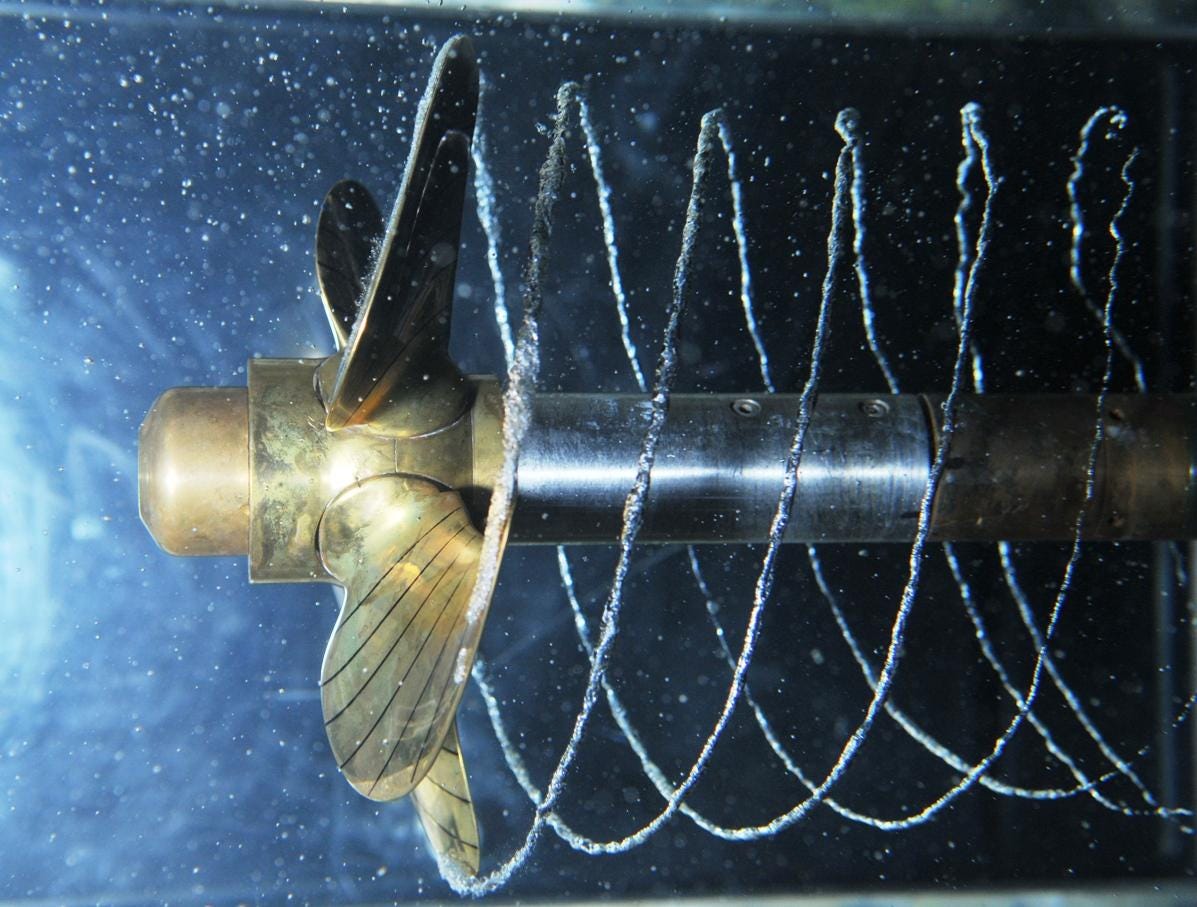
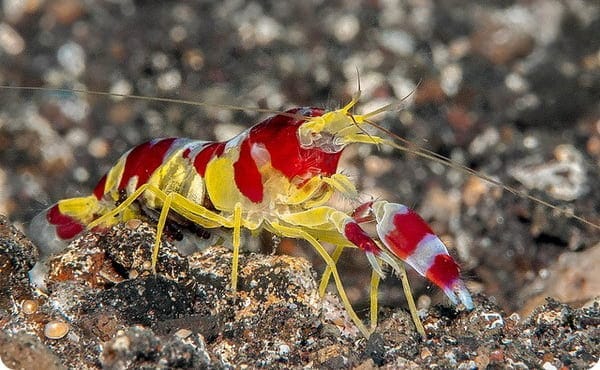

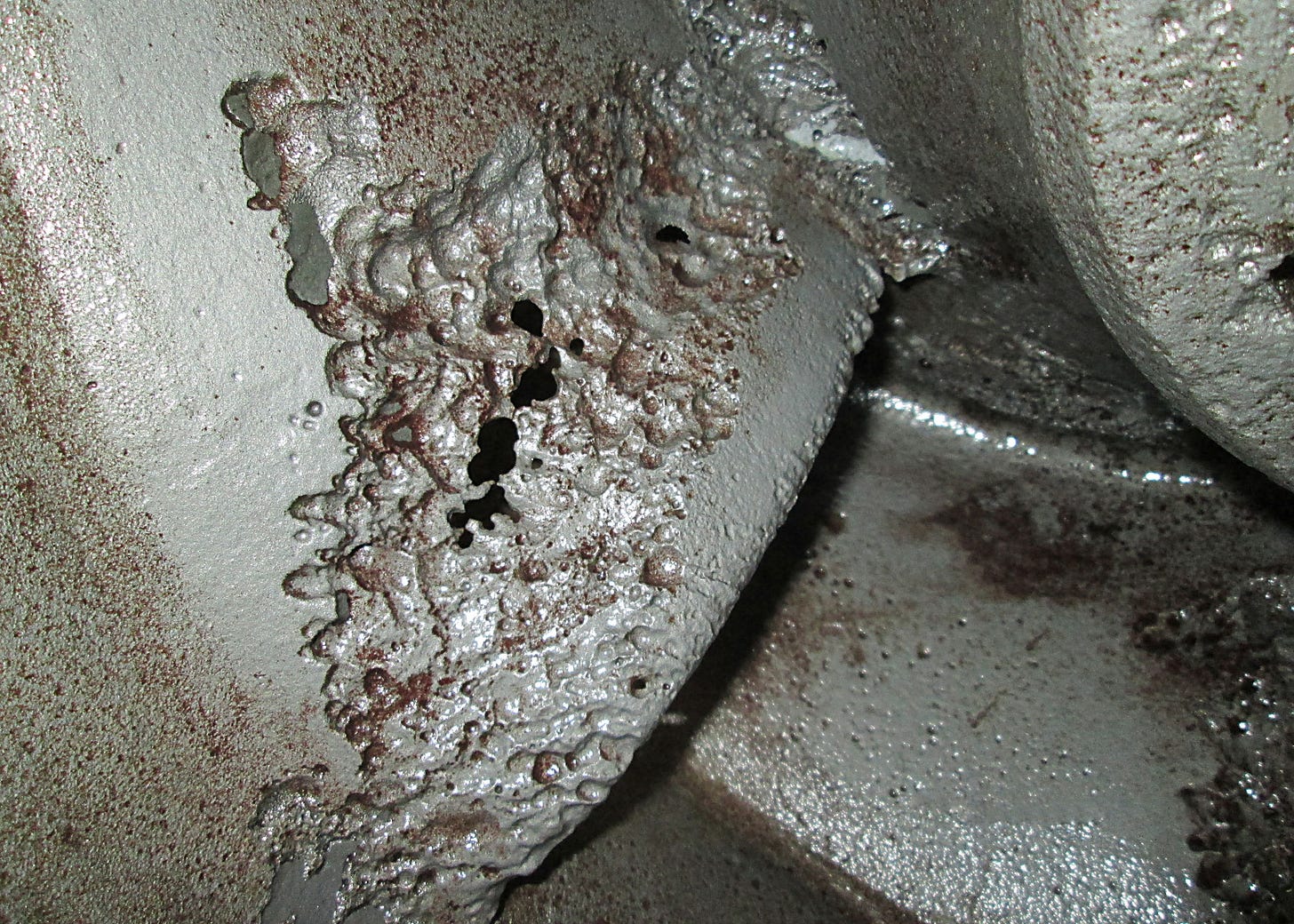

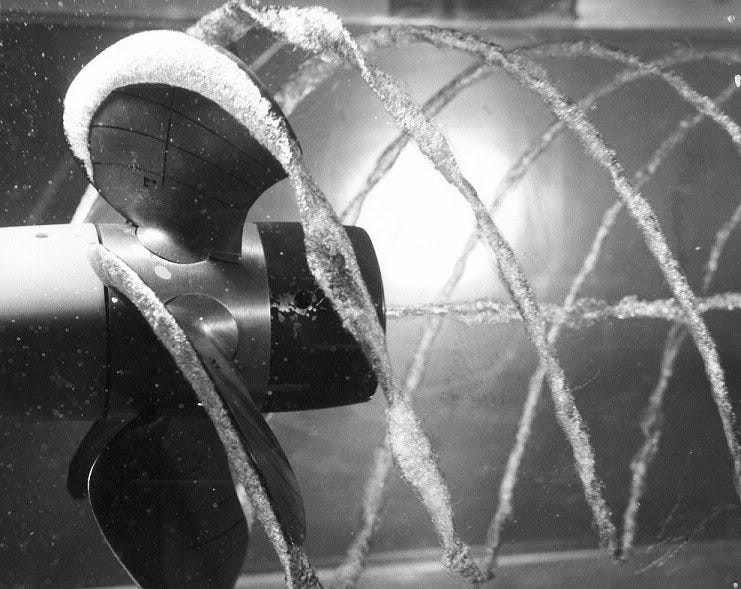

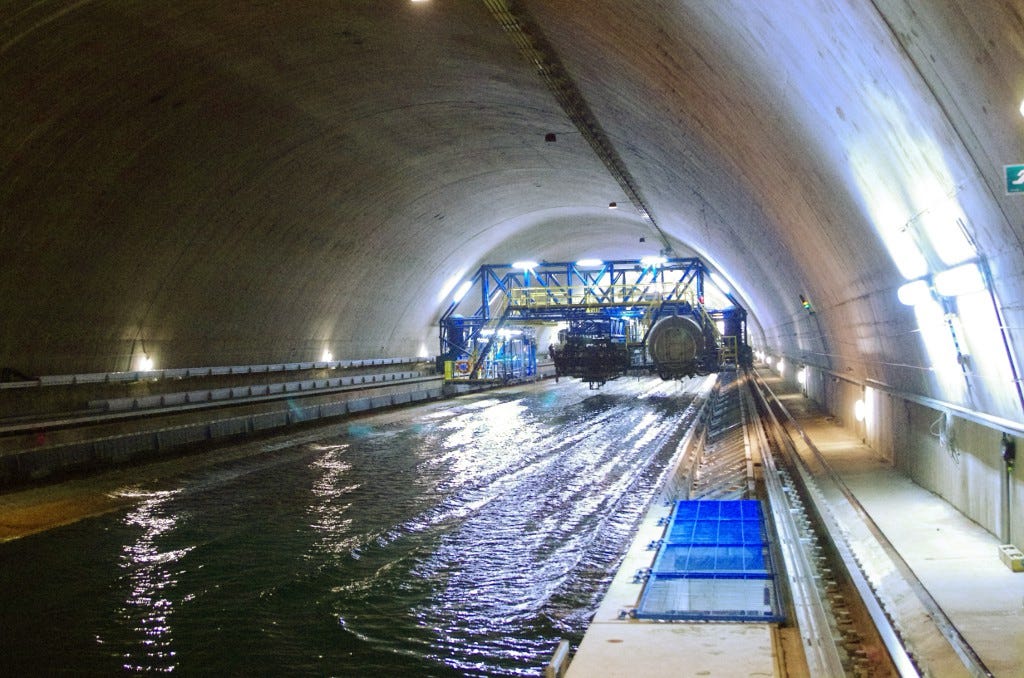

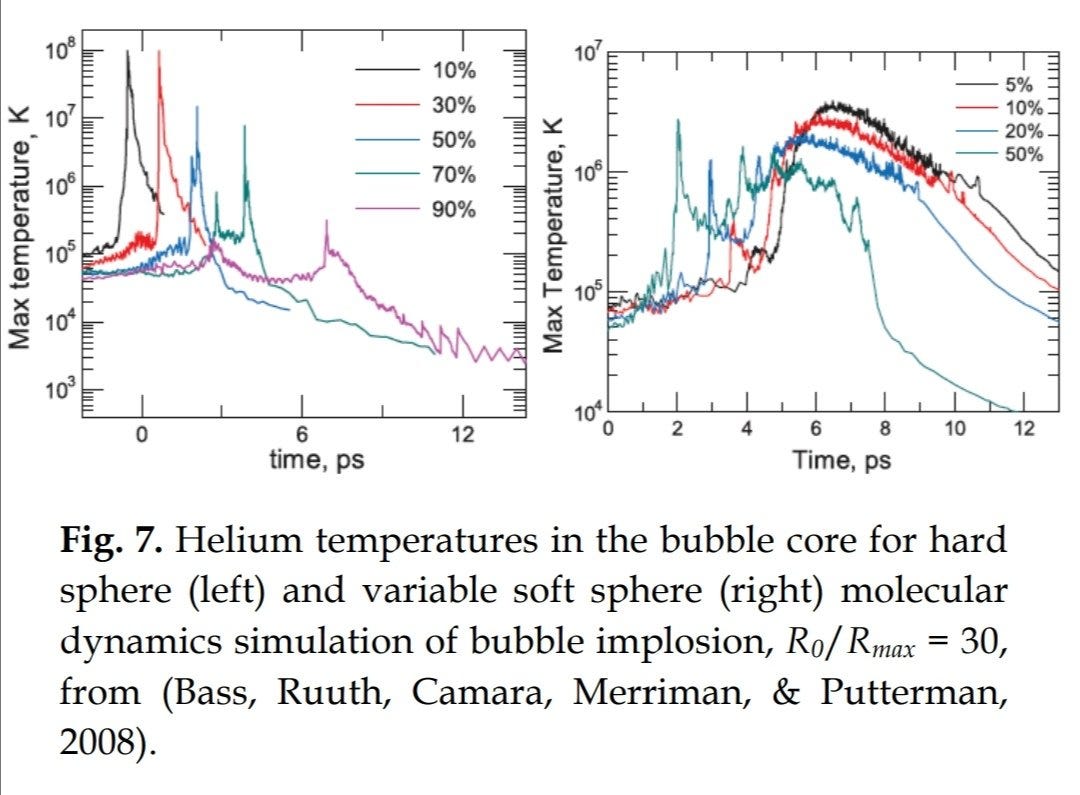
Thank you for sharing this. I try to learn something new each day and I this article provided me with several days of new stuff
I didn’t realise how much I didn’t know about this, nor how much I wanted to. Thank you.